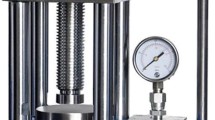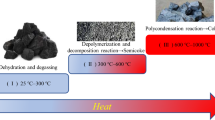Abstract
Moisture content is the main factor affecting the occurrence and flow of gas in bituminous coal and restricts the gas permeability of the coal seam, which affects the effectiveness of gas extraction from the coal seam directly. In order to study the influence of moisture content on the gas seepage characteristics of bituminous coal, this paper focused on bituminous coal from the Xutuan coal mine and used a bespoke laboratory unit called a Gas Flow and Displacement Testing Apparatus (GFDTA). The moisture content of bituminous coal was measured, and the axial and radial gas seepage experiments of bituminous coal under different moisture content conditions were carried out. The average original moisture content (1.3%) and the average saturated moisture content (2.4%) of the bituminous coal sample were obtained. It was observed that, with the increase of time, the original moisture content of the coal decreased with a negative exponential function and the wetting moisture content increased with an Exponential Association function. The gas axial seepage experimental results showed that when the moisture content was lower, the coal adsorbed CH4; when the moisture content was higher than Mad, the two fields of gas and liquid are coupled and affect the axial flow of the CH4, decreasing the moisture content. With higher moisture content, the interaction between the two is more readily evident and the diffusion behavior of the CH4 has a greater impact on the moisture content. Axial and radial gas seepage experiments, under the same gas pressure, axial pressure, and confining pressure, revealed that with the increase of moisture content, the axial and radial permeability of bituminous coal first increased and then decreased. This phenomenon is analyzed by the water lock effect, the effects of sorption on gas seepage and moisture content on gas adsorption effects. Among them, critical moisture content of approximately 1% exists when the axial and confining pressures are loaded or unloaded at the same time as well as the axial pressure loading or unloading alone. However, the critical moisture content is about 0.5% under confining pressure loading or unloading alone. In addition, in radial seepage experiments, it was observed that the volumetric strain of the coal decreased with the increase in the moisture content.




















Similar content being viewed by others
References
Bergen F, Spiers C, Floor G, Bots P (2009) Strain development in unconfined coals exposed to CO2, CH4, and Ar: effect of moisture. Int J Coal Geol 77(1–2):43–53
Cai J, You L, Hu X, Wang J, Peng R (2012) Prediction of effective permeability in porous media based on spontaneous imbibition effect. Int J Mod Phys C 23(07):1250054
Cai J, Wei W, Hu X, Liu R, Wang J (2017) Fractal characterization of dynamic fracture network extension in porous media. Fractals 25(2):1750023
Chen D, Pan Z, Liu J, Connell L (2012a) Modeling and simulation of moisture effect on gas storage and transport in coal seams. Energy Fuel 26(3):1695–1706
Chen Z, Liu J, Pan Z, Connell L, Elsworth D (2012b) Influence of the effective stress coefficient and sorption-induced strain on the evolution of coal permeability: model development and analysis. Int J Greenhouse Gas Control 8(5):101–110
Cheng CL, Perfect E, Donnelly B, Bilheux H, Tremsin A, McKay L, DiStefano V, Cai J, Santodonato L (2015) Rapid imbibition of water in fractures within unsaturated sedimentary rock. Adv Water Resour 77:82–89
Connell L, Lu M, Pan Z (2010) An analytical coal permeability model for tri-axial strain and stress conditions. Int J Coal Geol 84(2):103–114
Crosdale P, Moore T, Mares T (2008) Influence of moisture content and temperature on methane adsorption isotherm analysis for coals from a low-rank, biogenically-sourced gas reservoir. Int J Coal Geol 76(1):166–174
Fan C, Li S, Luo M, Du W, Yang Z (2017) Coal and gas outburst dynamic system. Int J Min Sci Technol 27(1):49–55
Fry R, Day S, Sakurovs R (2009) Moisture-induced swelling of coal. Int J Coal Prep Util 29(6):298–316
Han F, Busch A, Wageningen N V, Yang J, Liu Z, M. Krooss B (2010) Experimental study of gas and water transport processes in the inter-cleat (matrix) system of coal: Anthracite from Qinshui Basin, China. Int J Coal Geol 81(2):128–138
Li C, Dong L, Xu X, Hu P, Tian J, Zhang Y, Yang L (2017) Theoretical and experimental evaluation of effective stress-induced sorption capacity change and its influence on coal permeability. J Geophys Eng 14(3):654–665
Li X, Yan X, Kang Y (2018) Effect of temperature on permeability of gas adsorbed coal at triaxial stress conditions. J Geophys Eng 15(2):386–396
Lin BQ, Liu T, Zou QL, Zhu CJ, Yan FZ, Zhang Z (2015) Crack propagation patterns and energy evolution rules of coal within slotting disturbed zone under various lateral pressure coefficients. Arab J Geosci 8(9):6643–6654
Liu J, Chen Z, Elsworth D, Miao X, Mao X (2010) Linking gas-sorption induced changes in coal permeability to directional strains through a modulus reduction ratio. Int J Coal Geol 83(1):21–30
Liu Z, Li Z, Yang Y, Ji H (2014) Experimental study of effect of water on sorption and radial gas seepage of coal. Chin J Rock Mech Eng 33(3):586–593
Liu Z, Yang H, Cheng W, Xin L, Ni G (2017) Stress distribution characteristic analysis and control of coal and gas outburst disaster in a pressure-relief boundary area in protective layer mining. Arab J Geosci 10(16):358
Liu Z, Cao A, Guo X, Li J (2018) Deep-hole water injection technology of strong impact tendency coal seam—a case study in Tangkou coal mine. Arab J Geosci 11(2):12
Mahoney SA (2017) The effect of water occlusion on gas production in coal. - Doctor of Philosophy. The University of Queensland, Brisbane
Pan Z, Connell L (2012) Modelling permeability for coal reservoirs: a review of analytical models and testing data. Int J Coal Geol 92:1–44
Pan Z, Connell L, Camilleri M, Connelly L (2010) Effects of matrix moisture on gas diffusion and flow in coal. Fuel 89(11):3207–3217
Shen J, Qin Y, Wang G, Fu X, Wei C, Lei B (2011) Relative permeabilities of gas and water for different rank coals. Int J Coal Geol 86(2–3):266–275
Wang G, Wei X, Wang K, Massarotto P, Rudolph V (2010) Sorption-induced swelling/shrinkage and permeability of coal under stressed adsorption/desorption conditions. Int J Coal Geol 83(1):46–54
Wang S, Elsworth D, Liu J (2011) Permeability evolution in fractured coal: the roles of fracture geometry and water-content. Int J Coal Geol 87(1):13–25
Wang K, Du F, Wang G (2017) Investigation of gas pressure and temperature effects on the permeability and steady-state time of Chinese anthracite coal: an experimental study. J Nat Gas Sci Eng 40:179–188
Wei J, Qin H, Wang D (2014) Seepage characteristics of coal mass containing gas considering moisture effect in loading-unloading confining pressure test. J Min Safety Eng 31(6):987–994
Xu H, Tang D, Tang S, Zhao J, Meng Y, Tao S (2014) A dynamic prediction model for gas–water effective permeability based on coalbed methane production data. Int J Coal Geol 121(1):44–52
Yang Y, Wen Q (2017) Numerical simulation of gas-liquid two-phase flow in channel fracture pack. J Nat Gas Sci Eng 43:33–47
Ye Z, Zhang L, Hao D, Zhang C, Wang C (2017) Experimental study on the response characteristics of coal permeability to pore pressure under loading and unloading conditions. J Geophys Eng 14:1020–1031
Zhang C (2017) Coupling mechanism of stress-fracture-flow in high gas coal seam group and its impact on pressure relief extraction. - Doctor of Philosophy. China University of Mining and Technology, Xuzhou
Zhang H, Liu J, Elsworth D (2008) How sorption-induced matrix deformation affects gas flow in coal seams: a new FE model. Int J Rock Mech Min Sci 45(8):1226–1236
Zhang L, Ren T, Aziz N, Tu S (2014) Triaxial permeability testing and microstructure study of hard-to-drain coal from Sydney Basin, Australia. Int J Oil, Gas Coal Technol 8(4):432–448
Zhang C, Tu S, Bai Q, Yang G, Zhang L (2015) Evaluating pressure-relief mining performances based on surface gas venthole extraction data in longwall coal mines. J Nat Gas Sci Eng 24:431–440
Zhang C, Tu S, Zhang L, Bai Q, Yuan Y, Wang F (2016a) A methodology for determining the evolution law of gob permeability and its distributions in longwall coal mines. J Geophys Eng 13(2):181–193
Zhang L, Zhang C, Tu S, Tu H, Wang C (2016b) A study of directional permeability and gas injection to flush coal seam gas testing apparatus and method. Transp Porous Media 111(3):573–589
Zhang C, Tu S, Chen M, Zhang L (2017) Pressure-relief and methane production performance of pressure relief gas extraction technology in the longwall mining. J Geophys Eng 14(1):77–89
Zhou A, Wang K, Fan L, Kiryaeva T (2017) Gas-solid coupling laws for deep high-gas coal seams. Int J Min Sci Technol 27(4):675–679
Acknowledgments
This research is supported by the Fundamental Research Funds for the Central Universities (2017XKZD06) and the Priority Academic Programme Development of Higher Education Institutions in Jiangsu Province. The authors wish to thank the staff and management of the Xutuan coal mine in Huaibei Mining Group for providing the coal samples and related data used in this study.
Author information
Authors and Affiliations
Corresponding authors
Rights and permissions
About this article
Cite this article
Hao, D., Zhang, L., Ye, Z. et al. Experimental study on the effects of the moisture content of bituminous coal on its gas seepage characteristics. Arab J Geosci 11, 436 (2018). https://doi.org/10.1007/s12517-018-3758-1
Received:
Accepted:
Published:
DOI: https://doi.org/10.1007/s12517-018-3758-1




